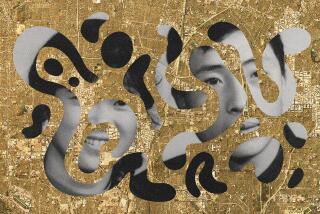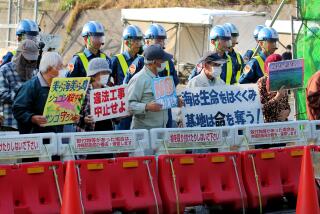U.S. Officials Saw All Japanese the Same : Internment: Youngster was among 1,800 from Orange County who were taken from homes, put in camps for the duration.
ANAHEIM — Hiroshi Kamei was 14 years old on Dec. 7, 1941, the son of farmers living in Westminster, a freshman at Huntington Beach High School. Your all-American kid, all in all, except for his parents. They were Japanese.
Kamei, now an Anaheim Hills resident and three times president of the Japanese American Citizens League’s chapter that covers North Orange County and southern Los Angeles County, says he didn’t think that much about the news of the Japanese attack at the time.
The next day he joined the other students in listening to President Franklin D. Roosevelt’s “day of infamy” speech. The other students didn’t bother him because of his ancestry, he says.
But not long after, a neighbor who had been a Marine in World War I, and sometimes drank too much, showed up in front of the Kamei home, bellowing racist remarks at Hiroshi’s father and urging him to come out and fight.
As the weeks went by, Kamei noticed more and more Japanese-Americans stopped going to school, though he said other students never made derogatory comments to him. But eventually he too dropped out, preferring to help work the farm with his folks. In April, the federal government rounded up Kamei, his parents, six brothers and sisters and grandparents. The family was sent to an internment camp operated by the U.S. government in rural Poston, Ariz.
“The Orange County Japanese opened Poston,” he said. From a population of zero, it went to 20,000 in six months, becoming “the third-largest community in Arizona.”
The official reason for interning Japanese and U.S. citizens who happened to be of Japanese descent was fear of a “fifth column” of spies that would help Japan in the war with America. Americans of German or Italian descent were not interned, though those countries too were at war with the United States.
In all, about 1,800 Japanese and Japanese-Americans from Orange County were interned.
It wasn’t until 30 years later, in 1976, that the federal government officially apologized. President Gerald R. Ford repealed the executive order signed by Roosevelt to intern the Japanese. President Ronald Reagan signed a bill giving $20,000 to each survivor of the camp as compensation.
During his three years in the camp, Kamei continued his education, even though classes were not compulsory and the school there was not accredited by the state, Kamei said.
But a teacher who knew the registrar of what is now Iowa State University helped Kamei gain admittance to that college in Ames, Iowa.
He enrolled there in June, 1945. Three months later, he was drafted into the U.S. Army, serving for a year and a half.
His parents returned to Orange County after being freed from the camp in November, 1945. Although most of their belongings had been stolen from their boarded-up house, they moved back in and resumed farming.
Kamei got out of the Army, graduated from Caltech and went to work as an engineer for North American Aviation and its successor, Rockwell. He retired four years ago.
Each Dec. 7, when America remembers Pearl Harbor, Kamei gets nervous. “It was a problem then, in 1941 and early 1942, that people couldn’t or wouldn’t make the distinction between Americans who happened to have Japanese parents and people from Japan,” Kamei says.
“And to this day there are still people who can’t seem to make that distinction.
“Most of us (Japanese-Americans) don’t want to be saying something about Dec. 7,” Kamei says, “because many people still have a hard time distinguishing. “We’re just as happy to see Dec. 7 come and go.”
More to Read
Sign up for Essential California
The most important California stories and recommendations in your inbox every morning.
You may occasionally receive promotional content from the Los Angeles Times.










